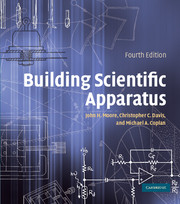3 - VACUUM TECHNOLOGY
Published online by Cambridge University Press: 05 August 2012
Summary
In the modern laboratory, there are many occasions when a gas-filled container must be emptied. Evacuation may simply be the first step in creating a new gaseous environment. In a distillation process, there may be a continuing requirement to remove gas as it evolves. Often it is necessary to evacuate a container to prevent air from contaminating a clean surface or interfering with a chemical reaction. Beams of atomic particles must be handled in vacuo to prevent loss of momentum through collisions with air molecules. Many forms of radiation are absorbed by air and thus can propagate over large distances only in a vacuum. A vacuum system is an essential part of laboratory instruments such as the mass spectrometer and the electron microscope. Far infrared and far ultraviolet spectrometers are operated within vacuum containers. Simple vacuum systems are used for vacuum dehydration and freeze-drying. Nuclear particle accelerators and thermonuclear devices require huge, sophisticated vacuum systems. Many modern industrial processes, most notably semiconductor device fabrication, require carefully controlled vacuum environments.
GASES
The pressure and composition of residual gases in a vacuum system vary considerably with its design and history. For some applications a residual gas density of tens of billions of molecules per cubic centimeter is tolerable. In other cases no more than a few hundred thousand molecules per cubic centimeter constitutes an acceptable vacuum: “One man's vacuum is another man's sewer”.
- Type
- Chapter
- Information
- Building Scientific Apparatus , pp. 93 - 146Publisher: Cambridge University PressPrint publication year: 2009
References
- 1
- Cited by

